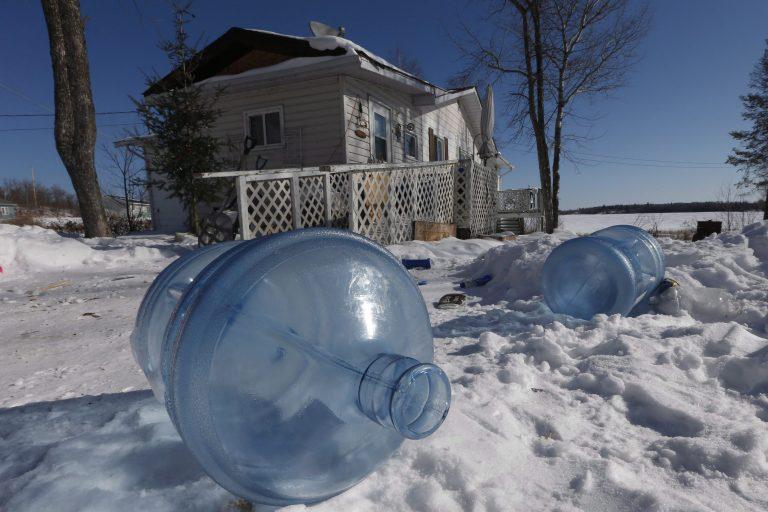Money alone won’t solve the water crisis in Indigenous communities
Opinion: There’s funding and political will, but only collaboration and integrated training in the communities themselves will provide a true solution

Empty 20 litre water bottles sit outside Laura Green’s house waiting for pickup and refilling Wednesday, February 25, 2015. The Shoal Lake community, despite supplying water to the city of Winnipeg, is under a boil water advisory and lacks year round road access. THE CANADIAN PRESS/John Woods
Share
John Millar is the executive director of Water First, a Canadian non-governmental organization focused on collaborating with First Nations to deliver community-based education programs that engage First Nations youth in the field of water science and water resource management. Bob Rae is an advisor to Water First and a senior partner at the law firm Olthuis Kleer Townshend LLP.
The Liberal government has vowed to devote the resources needed to reach their goal of eliminating all long-term boil-water advisories on public systems on reserve by 2021. But while progress is being made, there remain more than a hundred First Nations across Canada without access to safe, clean drinking water.
A recent report from the David Suzuki Foundation highlighted many of the challenges, many centring around this issue: Indigenous communities do not receive comparable education, training and employment supports when it comes to water science and management. Other reports, including ones by the Parliamentary Budget Officer and the Expert Panel on Safe Drinking Water for First Nations, also pointed to the critical role of these supports in ensuring the long-term sustainability of Indigenous water systems. Our own work with First Nations to address drinking and other water issues supports the conclusion that while infrastructure investments are urgently needed in many communities, these investments alone won’t have the desired impact on water quality outcomes. They need to be paired with significant investments in community-based training, education and employment initiatives that engage youth—the next generation of water stewards—and empower First Nations to take full ownership of their infrastructure.
Let’s put it this way: unless the water systems that are installed have an effective way of getting fixed and maintained, they won’t last. Installing the plumbing is not the big problem. Keeping it up and running is—and we need to make sure Indigenous people are the people who can do it.
READ MORE: Why can’t we get clean water to First Nations reserves?
After all, the greatest resource we have to address the water crisis in First Nations are the communities themselves. The role of non-Indigenous Canadians in this process is a supporting one, and should be guided by the spirit of reconciliation as laid out by the Truth and Reconciliation Commission. This starts with listening. Indigenous communities across Canada are working on solutions to their water challenges that suit their unique contexts, and in many cases the communities are concluding that the single reserve can’t be the exclusive focus for decision making; bigger groupings, like tribal councils, need to be involved. Meaningful collaboration with these efforts involves not only sharing resources and expertise, but also a sincere commitment to following local guidance and adapting training and other programs to community preferences and needs.
It follows then that water science education and training initiatives in First Nations need to reflect and integrate Indigenous values, traditions, and customs, and to that end those initiatives must be developed collaboratively with the communities they are delivered in. Solutions can no longer be imposed on communities. By incorporating local customs related to water stewardship and environmental monitoring and protection in training and education programs, we can ensure traditional knowledge is integrated with western science. This approach also ensures that training is culturally sensitive and meaningful, which leads to better outcomes.
Training also needs to be delivered locally whenever possible. This not only makes training more accessible, it also maintains connections between youth and their communities, increasing the likelihood they will put their new skills to use at home, where they are needed the most. Hands-on, experiential learning in the field and in local water treatment plants is one of the best ways to accomplish this.
Training, education and employment initiatives must also address the significant gap between Indigenous and non-Indigenous participation in the fields of science, technology, engineering and mathematics (STEM). As careers in STEM are often integral to community planning, decision-making and economic development, it is important that such careers are made accessible to Indigenous Canadians, particularly youth, who also have lower rates of employment than their non-Indigenous counterparts. Many communities are asking that their youth be given the same opportunity as non-Indigenous youth to explore and prepare for careers in STEM, and to receive the knowledge, skills and supports necessary to operate and maintain their community’s infrastructure.
READ MORE: The risks facing Canada’s drinking water
We need to continue to put the water crisis in Indigenous communities in a broader context by empowering communities to make their own decisions and be in a position to take full control of their own infrastructure. Support and funding for genuine self-government is essential. Over the years governments have invested a lot of money in water treatment infrastructure, but they have not done enough to help build the ability to sustain these structures.
We believe the political and social will to end the water crisis in Canada’s First Nations will continue to be as strong as ever. We need to ensure that the new investments being made by the federal government include training, education and employment initiatives for Indigenous communities and youth. Only then will we build sustainable solutions that last long past 2021.